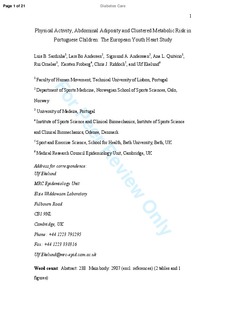| dc.contributor.author | Sardinha, Luis B. | |
| dc.contributor.author | Andersen, Lars Bo | |
| dc.contributor.author | Anderssen, Sigmund A. | |
| dc.contributor.author | Quitério, Ana L. | |
| dc.contributor.author | Ornelas, Rui | |
| dc.contributor.author | Froberg, Karsten | |
| dc.contributor.author | Riddoch, Chris J. | |
| dc.contributor.author | Ekelund, Ulf | |
| dc.date.accessioned | 2009-01-12T13:45:46Z | |
| dc.date.issued | 2007-12-10 | |
| dc.identifier | Seksjon for idrettsmedisinske fag / Department of Sports Medicine | |
| dc.identifier.citation | Diabetes Care. 2008, 31(3), 569-575 | en |
| dc.identifier.issn | 1935-5548 | |
| dc.identifier.uri | http://hdl.handle.net/11250/170607 | |
| dc.description | I Brage finner du siste tekst-versjon av artikkelen, og den kan inneholde ubetydelige forskjeller fra forlagets pdf-versjon. Forlagets pdf-versjon finner du på www.sciencedirect.com: http://dx.doi.org/10.2337/dc07-1286 / In Brage you'll find the final text version of the article, and it may contain insignificant differences from the journal's pdf version. The original publication is available at www.sciencedirect.com: http://dx.doi.org/10.2337/dc07-1286 | en |
| dc.description.abstract | OBJECTIVE—We examined the independent relationships between objectively measured physical activity and insulin resistance in Portuguese children.
RESEARCH DESIGN AND METHODS—This is a school-based, cross-sectional study in 147 randomly selected girls (aged 9.8 ± 0.3 years; 27.8 ± 9.3% body fat) and 161 boys (aged 9.8 ± 0.3 years; 22.0 ± 9.2% body fat). Physical activity was assessed by the Actigraph accelerometer for 4 days and summarized as time spent sedentary (accelerometer counts <500/min), in light-intensity (accelerometer counts 500–2,000/min), and in moderate- and vigorous-intensity activity (accelerometer counts >2,001/min). We measured total and central fat mass by dual-energy X-ray absorptiometry. Insulin resistance was expressed as the homeostasis model assessment score.
RESULTS—Time (min/day) spent sedentary was significantly and positively associated with insulin resistance (β-coefficient = 0.001 [95% CI 0.0002–0.002]; P = 0.013). Time spent in moderate- and vigorous-intensity physical activity (–0.002 [–0.003 to –0.001]; P = 0.0009) and overall physical activity (–0.001 [–0.008 to 0.003]; P < 0.0001) were significantly and inversely associated with insulin resistance. All associations remained statistically significant, although they were attenuated after further adjustments for sex, birth weight, sexual maturity, and total or central fat mass (P < 0.03).
CONCLUSIONS—Physical activity is associated with insulin resistance independent of total and central fat mass in children. Our results emphasize the importance of decreasing sedentary behavior and increasing time spent in moderate- and vigorous-intensity activity in children, which may have beneficial effects on metabolic risk factors regardless of the degree of adiposity.
Abbreviations: DEXA, dual-energy X-ray absorptiometry • HOMA-IR, homeostasis model assessment of insulin resistance • MVPA, moderate- and vigorous-intensity physical activity | en |
| dc.format.extent | 335608 bytes | |
| dc.format.mimetype | application/pdf | |
| dc.language.iso | eng | en |
| dc.publisher | American Diabetes Association | en |
| dc.subject | absorptiometry, photon | en |
| dc.subject | adipose tissue | en |
| dc.subject | child | en |
| dc.subject | cross-sectional studies | en |
| dc.subject | female | en |
| dc.subject | humans | en |
| dc.subject | insulin resistance | en |
| dc.subject | male | en |
| dc.subject | motor activity | en |
| dc.subject | Portugal | en |
| dc.subject | physiology | |
| dc.title | Objectively Measured Time Spent Sedentary Is Associated With Insulin Resistance Independent of Overall and Central Body Fat in 9- to 10-Year-Old Portuguese Children | en |
| dc.type | Peer reviewed | en |
| dc.type | Journal article | en |
| dc.subject.nsi | VDP::Medical disciplines:700 | |
| dc.source.pagenumber | 569-575 | en |
| dc.source.volume | 31 | en |
| dc.source.journal | Diabetes Care | en |
| dc.source.issue | 3 | en |
